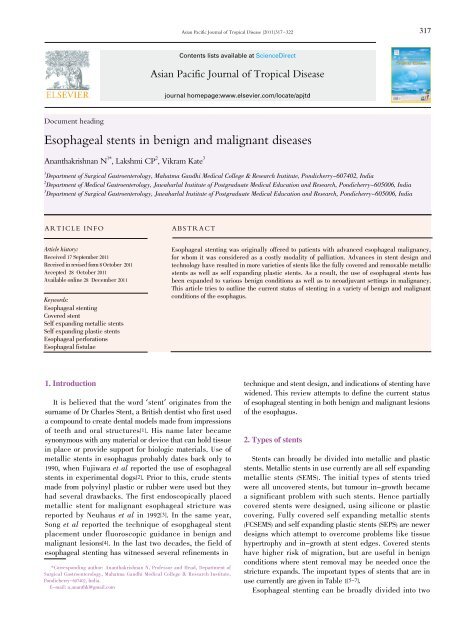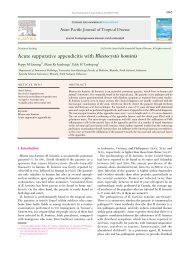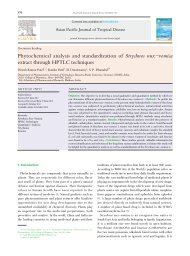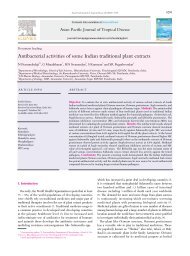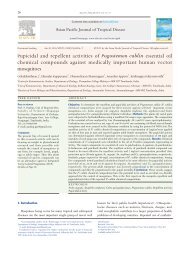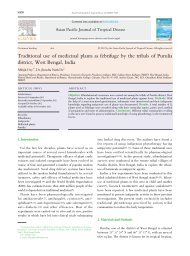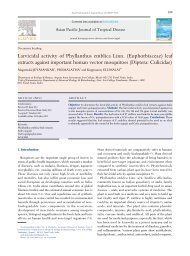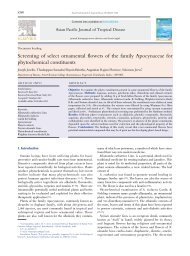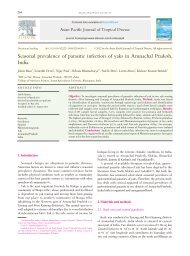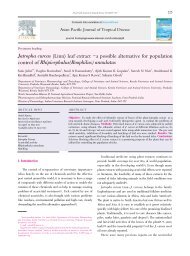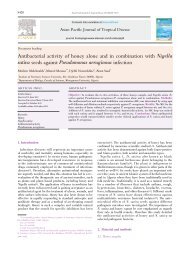Esophageal stents in benign and malignant diseases - Asian Pacific ...
Esophageal stents in benign and malignant diseases - Asian Pacific ...
Esophageal stents in benign and malignant diseases - Asian Pacific ...
Create successful ePaper yourself
Turn your PDF publications into a flip-book with our unique Google optimized e-Paper software.
Document head<strong>in</strong>g<br />
<strong>Esophageal</strong> <strong>stents</strong> <strong>in</strong> <strong>benign</strong> <strong>and</strong> <strong>malignant</strong> <strong>diseases</strong><br />
Ananthakrishnan N 1* , Lakshmi CP 2 , Vikram Kate 3<br />
1 Department of Surgical Gastroenterology, Mahatma G<strong>and</strong>hi Medical College & Research Institute, Pondicherry-607402, India<br />
2 Department of Medical Gastroenterology, Jawaharlal Institute of Postgraduate Medical Education <strong>and</strong> Research, Pondicherry-605006, India<br />
3 Department of Surgical Gastroenterology, Jawaharlal Institute of Postgraduate Medical Education <strong>and</strong> Research, Pondicherry-605006, India<br />
ARTICLE INFO ABSTRACT<br />
Article history:<br />
Received 17 September 2011<br />
Received <strong>in</strong> revised form 8 October 2011<br />
Accepted 28 October 2011<br />
Available onl<strong>in</strong>e 28 December 2011<br />
Keywords:<br />
<strong>Esophageal</strong> stent<strong>in</strong>g<br />
Covered stent<br />
Self exp<strong>and</strong><strong>in</strong>g metallic <strong>stents</strong><br />
Self exp<strong>and</strong><strong>in</strong>g plastic <strong>stents</strong><br />
<strong>Esophageal</strong> perforations<br />
<strong>Esophageal</strong> fistulae<br />
1. Introduction<br />
It is believed that the word ‘stent’ orig<strong>in</strong>ates from the<br />
surname of Dr Charles Stent, a British dentist who first used<br />
a compound to create dental models made from impressions<br />
of teeth <strong>and</strong> oral structures[1]. His name later became<br />
synonymous with any material or device that can hold tissue<br />
<strong>in</strong> place or provide support for biologic materials. Use of<br />
metallic <strong>stents</strong> <strong>in</strong> esophagus probably dates back only to<br />
1990, when Fujiwara et al reported the use of esophageal<br />
<strong>stents</strong> <strong>in</strong> experimental dogs[2]. Prior to this, crude <strong>stents</strong><br />
made from polyv<strong>in</strong>yl plastic or rubber were used but they<br />
had several drawbacks. The first endoscopically placed<br />
metallic stent for <strong>malignant</strong> esophageal stricture was<br />
reported by Neuhaus et al <strong>in</strong> 1992[3]. In the same year,<br />
Song et al reported the technique of esopghageal stent<br />
placement under fluoroscopic guidance <strong>in</strong> <strong>benign</strong> <strong>and</strong><br />
<strong>malignant</strong> lesions[4]. In the last two decades, the field of<br />
esophageal stent<strong>in</strong>g has witnessed several ref<strong>in</strong>ements <strong>in</strong><br />
*Correspond<strong>in</strong>g author: Ananthakrishnan N, Professor <strong>and</strong> Head, Department of<br />
Surgical Gastroenterology, Mahatma G<strong>and</strong>hi Medical College & Research Institute,<br />
Pondicherry-607402, India.<br />
E-mail: n.ananthk@gmail.com<br />
<strong>Asian</strong> <strong>Pacific</strong> Journal of Tropical Disease (2011)317-322<br />
Contents lists available at ScienceDirect<br />
<strong>Asian</strong> <strong>Pacific</strong> Journal of Tropical Disease<br />
journal homepage:www.elsevier.com/locate/apjtd<br />
317<br />
<strong>Esophageal</strong> stent<strong>in</strong>g was orig<strong>in</strong>ally offered to patients with advanced esophageal malignancy,<br />
for whom it was considered as a costly modality of palliation. Advances <strong>in</strong> stent design <strong>and</strong><br />
technology have resulted <strong>in</strong> more varieties of <strong>stents</strong> like the fully covered <strong>and</strong> removable metallic<br />
<strong>stents</strong> as well as self exp<strong>and</strong><strong>in</strong>g plastic <strong>stents</strong>. As a result, the use of esophageal <strong>stents</strong> has<br />
been exp<strong>and</strong>ed to various <strong>benign</strong> conditions as well as to neoadjuvant sett<strong>in</strong>gs <strong>in</strong> malignancy.<br />
This article tries to outl<strong>in</strong>e the current status of stent<strong>in</strong>g <strong>in</strong> a variety of <strong>benign</strong> <strong>and</strong> <strong>malignant</strong><br />
conditions of the esophagus.<br />
technique <strong>and</strong> stent design, <strong>and</strong> <strong>in</strong>dications of stent<strong>in</strong>g have<br />
widened. This review attempts to def<strong>in</strong>e the current status<br />
of esophageal stent<strong>in</strong>g <strong>in</strong> both <strong>benign</strong> <strong>and</strong> <strong>malignant</strong> lesions<br />
of the esophagus.<br />
2. Types of <strong>stents</strong><br />
Stents can broadly be divided <strong>in</strong>to metallic <strong>and</strong> plastic<br />
<strong>stents</strong>. Metallic <strong>stents</strong> <strong>in</strong> use currently are all self exp<strong>and</strong><strong>in</strong>g<br />
metallic <strong>stents</strong> (SEMS). The <strong>in</strong>itial types of <strong>stents</strong> tried<br />
were all uncovered <strong>stents</strong>, but tumour <strong>in</strong>-growth became<br />
a significant problem with such <strong>stents</strong>. Hence partially<br />
covered <strong>stents</strong> were designed, us<strong>in</strong>g silicone or plastic<br />
cover<strong>in</strong>g. Fully covered self exp<strong>and</strong><strong>in</strong>g metallic <strong>stents</strong><br />
(FCSEMS) <strong>and</strong> self exp<strong>and</strong><strong>in</strong>g plastic <strong>stents</strong> (SEPS) are newer<br />
designs which attempt to overcome problems like tissue<br />
hypertrophy <strong>and</strong> <strong>in</strong>-growth at stent edges. Covered <strong>stents</strong><br />
have higher risk of migration, but are useful <strong>in</strong> <strong>benign</strong><br />
conditions where stent removal may be needed once the<br />
stricture exp<strong>and</strong>s. The important types of <strong>stents</strong> that are <strong>in</strong><br />
use currently are given <strong>in</strong> Table 1[5-7].<br />
<strong>Esophageal</strong> stent<strong>in</strong>g can be broadly divided <strong>in</strong>to two
318<br />
Table 1<br />
Different types of esophageal <strong>stents</strong> commercially available.<br />
types: 1) <strong>stents</strong> used <strong>in</strong> various <strong>benign</strong> conditions of the<br />
esophagus; 2) <strong>stents</strong> used <strong>in</strong> esophageal malignancy.<br />
3. <strong>Esophageal</strong> stent<strong>in</strong>g <strong>in</strong> <strong>benign</strong> conditions of the<br />
esophagus<br />
<strong>Esophageal</strong> stent<strong>in</strong>g has been tried <strong>in</strong> several <strong>benign</strong><br />
conditions of the esophagus especially <strong>benign</strong> strictures,<br />
post esophagectomy leaks, esophageal perforations, <strong>and</strong><br />
esophageal fistulae. The two broad types of <strong>stents</strong> tried <strong>in</strong><br />
these cases are the FCSEMS <strong>and</strong> the SEPS.<br />
3.1. FCSEMS<br />
There is recent <strong>in</strong>terest <strong>in</strong> the use of FCSEMS <strong>in</strong> <strong>benign</strong><br />
lesions. A commercially available version called Alimaxx<br />
E (Alveolus Inc., Charlotte, NC) has been studied <strong>in</strong> small<br />
series of <strong>benign</strong> conditions <strong>in</strong> at least 3 series, by Eloubeidi<br />
et al[8], Bakken et al[9] <strong>and</strong> Senousy et al[10]. Other FCSEMS<br />
commercially available <strong>in</strong>clude the Wallflex esophageal<br />
stent (Boston Scientific Inc, Natick, Mass), Bonastent<br />
esophageal stent (St<strong>and</strong>ard Sci-Tech, Seoul, Korea), <strong>and</strong><br />
Evolution esophageal stent (Cook Medical Inc, W<strong>in</strong>ston-<br />
Salem, NC). Buscaglia et al[11] recently reported their<br />
experience with all the above 4 types of FCSEMS <strong>in</strong> <strong>benign</strong><br />
lesions. All these authors reported good procedural success,<br />
with removability rates rang<strong>in</strong>g from 95%-100%, with little<br />
tissue reaction. But the major limit<strong>in</strong>g factor was the high<br />
Ananthakrishnan N et al./<strong>Asian</strong> Paicfic Journal of Tropical Disease (2011)317-322<br />
Type of stent Name Manufacturer Special features<br />
Sta<strong>in</strong>less steel <strong>stents</strong> Gianturco Z stent Cook Partially covered stent woven <strong>in</strong> <strong>in</strong>terlock<strong>in</strong>g Z configuration<br />
Sta<strong>in</strong>less steel <strong>stents</strong> Dua antireflux stent Cook Z stent with a polyv<strong>in</strong>yl “w<strong>in</strong>dsock” extension of the wrap at the distal end<br />
Sta<strong>in</strong>less steel <strong>stents</strong> Flam<strong>in</strong>go stent Boston Scientific Asymmetric, funnel-shaped, with greater radial expansion proximally, to reduce<br />
migration across the esophagogastric junction<br />
Nit<strong>in</strong>ol stent Ultraflex stent Boston Scientific Partially covered with polyurethane at the mid portion, flexible knitted loop<br />
design<br />
Nit<strong>in</strong>ol stent Wallstent Boston Scientific Available <strong>in</strong> partially <strong>and</strong> fully covered versions (silicone cover<strong>in</strong>g) with<br />
progressive step flared edge design<br />
Nit<strong>in</strong>ol stent Evolution Cook Hav<strong>in</strong>g an <strong>in</strong>ternal <strong>and</strong> external silicone membrane to resist tumor <strong>and</strong><br />
granulation tissue on the one h<strong>and</strong> <strong>and</strong> to facilitate food passage <strong>and</strong> also hav<strong>in</strong>g<br />
uncoated flanges (dogbone shape)<br />
Nit<strong>in</strong>ol stent Alimaxx EE Alveolus Laser cut nit<strong>in</strong>ol stent with polyurethane cover, with antimigration struts<br />
Nit<strong>in</strong>ol stent Niti S Tae Woong Medical Uncovered second layer over silicone covered first layer to prevent migration<br />
Nit<strong>in</strong>ol stent Choo stent MI tech Polyurethane covered, <strong>and</strong> also hav<strong>in</strong>g an antireflux variant<br />
Nit<strong>in</strong>ol stent Bona stent St<strong>and</strong>ard Sci Tech Silicone covered, hav<strong>in</strong>g a fixed flexible <strong>and</strong> stable <strong>in</strong>ner antireflux valve (Shim’s<br />
modification)<br />
Polyester <strong>stents</strong> Polyflex stent Boston scientific Made of polyester mesh <strong>and</strong> covered with a silicone membrane<br />
Table 2<br />
SEPS <strong>in</strong> <strong>benign</strong> esophageal disorders.<br />
rates of stent migration, upto 35% <strong>and</strong> low cl<strong>in</strong>ical success,<br />
(especially <strong>in</strong> strictures) lowest be<strong>in</strong>g 29% [8-12]. Prelim<strong>in</strong>ary<br />
data on experimental animals provide hope for emerg<strong>in</strong>g<br />
therapeutic modalities like drug elut<strong>in</strong>g <strong>stents</strong> to overcome<br />
these limitations[13].<br />
3.2. SEPS<br />
SEPS has been studied by several authors <strong>in</strong> various<br />
<strong>benign</strong> disorders of the esophagus especially strictures.<br />
Table 2 summarizes some of the data available from larger<br />
series <strong>in</strong> this regard.<br />
SEPS also has high migration rates <strong>and</strong> though immediate<br />
cl<strong>in</strong>ical success may be achieved <strong>in</strong> strictures, long term<br />
success rates cont<strong>in</strong>ue to be low. A pooled data analysis<br />
concludes that cl<strong>in</strong>ical success is achieved <strong>in</strong> 52% patients<br />
only <strong>and</strong> the rates are lower for high level strictures. Stent<br />
migration is seen <strong>in</strong> about 24% cases <strong>and</strong> life threaten<strong>in</strong>g<br />
complications <strong>and</strong> even death may occur[19].<br />
3.3. Issues to be considered <strong>in</strong> stent<strong>in</strong>g for <strong>benign</strong> conditions<br />
Stent<strong>in</strong>g for <strong>benign</strong> conditions has the follow<strong>in</strong>g<br />
limitations: 1) In absence of a stenosis, <strong>in</strong> conditions like<br />
leaks <strong>and</strong> perforations, the <strong>stents</strong> may not hold <strong>and</strong> tend to<br />
migrate; 2) If SEMS with uncovered ends are used, tissue<br />
hyperplasia at the ends tends to prevent migration, but can<br />
<strong>in</strong>duce esophageal stenosis later after stent removal.<br />
Some authors advocate that <strong>stents</strong> placed for <strong>benign</strong><br />
Author, year Number of patients Cl<strong>in</strong>ical improvement/success Migration rate Other significant complications<br />
Karbowski, 2008 [14] 27 90% 29.6% One trachea esophageal fistula<br />
Evrad, 2004 [15] 21 80.9% 14.3% One case of tracheal compression<br />
Dua, 2008 [16] 40 66% 22% One case of massive bleed<strong>in</strong>g <strong>and</strong> mortality<br />
Holm, 2008 [17] 30 92.8%, (only 6% long term improvement<br />
after removal)<br />
62.1% Perforation, tracheal compression<br />
Ott, 2007 [18] 13 92% 37% One case of esophageal perforation
conditions should be removed after 6 weeks, but the lesion<br />
may not be corrected by this time <strong>and</strong> removal per se may<br />
cause severe bleed<strong>in</strong>g[20]. Another method is to deploy a<br />
SEPS <strong>in</strong>side a SEMS <strong>in</strong> <strong>benign</strong> conditions to facilitate easy<br />
removal when required. A recent retrospective analysis<br />
provides the largest data available so far on stent<strong>in</strong>g <strong>in</strong><br />
<strong>benign</strong> conditions, where 153 <strong>stents</strong> were deployed <strong>in</strong> 88<br />
patients. This centre used a SEMS to treat the primary lesion<br />
like a perforation or a leak. Tissue hyperplasia at stent edges<br />
causes difficult removal, hence a SEPS was deployed <strong>in</strong>side<br />
the SEMS, which would exp<strong>and</strong> <strong>and</strong> cause pressure necrosis<br />
of the area of hyperplasia <strong>and</strong> facilitate easy removal of the<br />
SEMS. This technique produced cl<strong>in</strong>ical success <strong>in</strong> 77.6%<br />
cases, with low migration rates of 11.1% [21].<br />
4. Benign esophageal lesions requir<strong>in</strong>g stent<strong>in</strong>g<br />
The various <strong>benign</strong> conditions of the esophagus which<br />
necessitate stent<strong>in</strong>g <strong>in</strong>clude <strong>benign</strong> strictures, post<br />
esophagectomy leaks <strong>and</strong> strictures, esophageal perforations<br />
<strong>and</strong> esophageal fistulae.<br />
4.1. Benign strictures<br />
Benign strictures may arise <strong>in</strong> the esophagus secondary<br />
to a variety of causes like peptic esophagitis, corrosive<br />
<strong>in</strong>gestion, post radiation strictures, etc. The <strong>in</strong>itial therapy<br />
of choice <strong>in</strong> such cases is serial endoscopic dilatation.<br />
But there are cases of tight strictures that are recurrent<br />
to repeated balloon dilation with patient refusal of or<br />
<strong>in</strong>ability to undergo surgical correction. These cases<br />
may be considered for placement of esophageal <strong>stents</strong> of<br />
various types[5]. There are no r<strong>and</strong>omized controlled trials<br />
<strong>in</strong> literature compar<strong>in</strong>g different types of <strong>stents</strong> <strong>in</strong> <strong>benign</strong><br />
esophageal strictures. Hence, data available <strong>in</strong> this regard<br />
have their own limitations. The available data on FCSEMS<br />
<strong>and</strong> SEPS have already been discussed. The cl<strong>in</strong>ical success<br />
rates like 29% are among the lowest for this group when<br />
compared to other <strong>benign</strong> conditions.<br />
4.2. Post esophagectomy leaks <strong>and</strong> strictures<br />
Intrathoracic anastomotic leak after esophagectomy<br />
for <strong>benign</strong> or <strong>malignant</strong> conditions is an important cause<br />
of morbidity. Placement of endolum<strong>in</strong>al <strong>stents</strong> has been<br />
reported to be effective <strong>in</strong> controll<strong>in</strong>g these leaks[21-24]. In a<br />
large series, upto 77.6% of patients with post operative leaks<br />
responded to stent<strong>in</strong>g with a median duration of FCSEMS<br />
treatment of 83 days[20]. Polyflex type of SEPS has also been<br />
used <strong>in</strong> such situations with equally good success rates[25,26].<br />
Similarly, small case series also report the use of FCSEMS<br />
<strong>in</strong> the management of post esophagectomy anastomotic<br />
strictures[27]. Improvement <strong>in</strong> quality of life <strong>and</strong> symptomatic<br />
relief is achieved <strong>in</strong> patients who undergo stent<strong>in</strong>g when<br />
<strong>in</strong>itial few attempts at dilatation of post operative strictures<br />
fail.<br />
Ananthakrishnan N et al./<strong>Asian</strong> Paicfic Journal of Tropical Disease (2011)317-322 319<br />
4.3. <strong>Esophageal</strong> perforations<br />
<strong>Esophageal</strong> perforations are most commonly iatrogenic, but<br />
some may also be spontaneous, as <strong>in</strong> Boerhaeve’s syndrome.<br />
Irrespective of the etiology, they carry a poor prognosis.<br />
<strong>Esophageal</strong> stent<strong>in</strong>g is evolv<strong>in</strong>g as a less morbid option <strong>in</strong><br />
the management of these conditions. Various case series<br />
show heal<strong>in</strong>g rates upto 97% [20,28]. There are no r<strong>and</strong>omized<br />
controlled trials compar<strong>in</strong>g surgical management <strong>and</strong><br />
stent<strong>in</strong>g. However, some retrospective data show that<br />
outcome of iatrogenic perforations is significantly better if<br />
stent<strong>in</strong>g is done immediately after the perforation[29].<br />
4.4. <strong>Esophageal</strong> fistulae<br />
<strong>Esophageal</strong> stent<strong>in</strong>g has also been reported with good<br />
success rates <strong>in</strong> heal<strong>in</strong>g of trachea esophageal fistulae<br />
<strong>in</strong> critically ill ventilated patients who are not otherwise<br />
c<strong>and</strong>idates for any other form of surgical management[30].<br />
In short, esophageal stent<strong>in</strong>g is a def<strong>in</strong>ite treatment<br />
modality <strong>in</strong> the management of various <strong>benign</strong> conditions of<br />
esophagus like post surgical leaks, iatrogenic perforations,<br />
strictures <strong>and</strong> fistulae, which have a high mortality rate with<br />
surgical management. However, data are limited to case<br />
series <strong>and</strong> r<strong>and</strong>omized controlled trials are lack<strong>in</strong>g.<br />
5. <strong>Esophageal</strong> stent<strong>in</strong>g <strong>in</strong> malignancy<br />
<strong>Esophageal</strong> stent<strong>in</strong>g for cancer can broadly be divided <strong>in</strong>to<br />
two types: 1) those for palliation <strong>in</strong> advanced cases; 2) those<br />
for neoadjuvant therapy.<br />
5.1. Palliative esophageal stent<strong>in</strong>g <strong>in</strong> malignancy<br />
Data from several large series show that SEMS placement<br />
is a safe technique to achieve good symptom palliation <strong>in</strong><br />
patients with advanced esophageal cancer[31-36]. Stent<strong>in</strong>g<br />
may be done under either endoscopic or fluoroscopic<br />
guidance. Successful stent placements are achieved<br />
<strong>in</strong> upto 98% cases[31]. M<strong>in</strong>or procedural complications<br />
which lead to morbidity were seen <strong>in</strong> upto 26% to 45% <strong>in</strong><br />
various series[31-36]. Complication rates have traditionally<br />
been considered to be higher <strong>in</strong> patients with proximal<br />
esophageal cancers. But a recent study showed stent related<br />
complications <strong>in</strong> 26.9% of patients with proximal cancers,<br />
which was not significantly different from that <strong>in</strong> patients<br />
with distal cancers[37]. Apart from <strong>malignant</strong> strictures,<br />
esophageal fistulae secondary to advanced malignancy<br />
also respond well to placement of covered SEMS[33,38].<br />
Airway stent<strong>in</strong>g may also need to be added <strong>in</strong> some of these<br />
patients[39].<br />
<strong>Esophageal</strong> stent<strong>in</strong>g is a mode of palliation <strong>and</strong> <strong>in</strong><br />
advanced malignancies it has been shown to improve quality<br />
of life <strong>in</strong>dices[40]. Data from our centre show significant<br />
improvement <strong>in</strong> quality of life post stent<strong>in</strong>g <strong>in</strong> a cohort of 30<br />
patients with advanced esophageal malignancy[41]. However,<br />
it is controversial whether there is any survival benefit <strong>in</strong>
320<br />
patients treated with radiotherapy <strong>and</strong> or chemotherapy after<br />
stent<strong>in</strong>g[42-45].<br />
5.2. <strong>Esophageal</strong> stent<strong>in</strong>g <strong>in</strong> the neoadjuvant sett<strong>in</strong>g<br />
Due to the presence of dysphagia, nutritional compromise<br />
is extremely common <strong>in</strong> patients undergo<strong>in</strong>g neoadjuvant<br />
therapy for esophageal cancers, which results <strong>in</strong> worse<br />
outcomes <strong>in</strong> surgery. SEMS <strong>in</strong>sertion if done <strong>in</strong> this sett<strong>in</strong>g<br />
was classically thought to be associated with risk of stent<br />
related complications as well as difficulties <strong>in</strong> surgery later<br />
on. However, with the advent of self exp<strong>and</strong><strong>in</strong>g removable<br />
metallic <strong>stents</strong> (SERMS), i.e. the FCSEMS, there is a renewed<br />
<strong>in</strong>terest <strong>in</strong> this regard.<br />
Studies have shown that SERMS <strong>in</strong> the neoadjuvant sett<strong>in</strong>g<br />
is safe <strong>and</strong> improves symptoms as well as nutrition[46-48].<br />
There was significant fall <strong>in</strong> dysphagia scores <strong>and</strong><br />
performance status after stent<strong>in</strong>g <strong>in</strong> these series. However,<br />
stent migration is a problem <strong>in</strong> this sett<strong>in</strong>g also, with<br />
migration rates upto 43.8% [48]. Tissue reaction to <strong>stents</strong><br />
occurs but does not appear to impair removability. The<br />
above series showed 100% removability, but one of these<br />
authors[47] reported ulcerations at the proximal or distal edge<br />
of <strong>stents</strong> on removal <strong>in</strong> 75%, polyps <strong>in</strong> 50%, <strong>and</strong> granulation<br />
<strong>in</strong> 75%. There was no <strong>in</strong>creased risk of perioperative<br />
complications due to stent<strong>in</strong>g <strong>in</strong> all these series. However,<br />
all available data <strong>in</strong> this regard are limited to prospective<br />
studies <strong>and</strong> r<strong>and</strong>omized controlled trials <strong>in</strong> this regard are<br />
necessary.<br />
5.3. Which esophageal stent to choose <strong>in</strong> esophageal<br />
malignancy?<br />
Either covered, uncovered or plastic <strong>stents</strong> may be used<br />
<strong>in</strong> the esophagus. There are a few studies available, which<br />
compare the different commercially available types of<br />
<strong>stents</strong>. Eickhoff et al <strong>in</strong> their study on 150 patients found<br />
that the major complication rate of the Gianturco Z stent<br />
was significantly higher when compared to the complication<br />
rate of the Ultraflex stent <strong>and</strong> the Flam<strong>in</strong>go Wallstent[49].<br />
Verschuur et al found that the complication rates are higher<br />
for the Gianturco Z stent if the large diameter version is<br />
used[50].<br />
Table 3 summarizes the results of some of the r<strong>and</strong>omized<br />
controlled trials available <strong>in</strong> literature between different<br />
types of esophgeal <strong>stents</strong>.<br />
5.4. SEPS or SEMS?<br />
Ananthakrishnan N et al./<strong>Asian</strong> Paicfic Journal of Tropical Disease (2011)317-322<br />
Table 3<br />
R<strong>and</strong>omized controlled trials compar<strong>in</strong>g different types of <strong>stents</strong> <strong>in</strong> esophageal malignancy.<br />
Author, year Number of patients Stents compared Result<br />
Siersema, 2001 [51] 100 Ultraflex stent, Flam<strong>in</strong>go wallstent, Similar degree of palliation, Gianturco Z associated with more<br />
Gianturco Z stent<br />
complications<br />
Sabharwal, 2003 [52] 53 Ultraflex, Flam<strong>in</strong>go wallstent Both are equally effective<br />
Conjo, 2007(53) 101 Polyflex, Ultraflex Similar degree of palliation, migration more with Polyflex<br />
Verschuur, 2008 [54] 125 Ultraflex, Polyflex, Niti S Similar degree of palliation, Polyflex associated with <strong>in</strong>creased<br />
migration <strong>and</strong> difficult placement<br />
As noted <strong>in</strong> Table 3, Polyflex <strong>stents</strong> are technically more<br />
difficult to place <strong>and</strong> have higher chance of migration. But,<br />
they achiveve almost equal degree of palliation <strong>and</strong> are<br />
useful <strong>in</strong> management of patients with tissue <strong>in</strong>-growth after<br />
SEMS placement[55].<br />
A meta-analysis of available data suggests that SEMS are<br />
superior to SEPS <strong>in</strong> terms of stent <strong>in</strong>sertion-related mortality,<br />
morbidity, <strong>and</strong> quality of palliation. The uncovered variety of<br />
<strong>stents</strong> is disadvantaged by high rate of tumor <strong>in</strong>-growth[56].<br />
These facts should be considered <strong>in</strong> choos<strong>in</strong>g the type of<br />
stent to be used <strong>in</strong> a particular patient.<br />
5.5. Antireflux <strong>stents</strong><br />
In patients with distal esophageal malignancy, severe<br />
reflux symptoms are common with conventional <strong>stents</strong>.<br />
Antireflux <strong>stents</strong> which <strong>in</strong>corporate a valve or w<strong>in</strong>dsock like<br />
mechanism at the distal end have been tried <strong>in</strong> these cases.<br />
R<strong>and</strong>omized controlled trials have shown that antireflux<br />
<strong>stents</strong> lead to improvement <strong>in</strong> symptoms of reflux compared<br />
to conventional <strong>stents</strong>, although palliation of dysphagia<br />
<strong>and</strong> improvement <strong>in</strong> quality of life are similar <strong>in</strong> both<br />
groups[57-59].<br />
6. Cost effectiveness<br />
Although esophageal stent<strong>in</strong>g has been shown to be a<br />
safe <strong>and</strong> effective modality of palliation <strong>in</strong> patients with<br />
advanced esophageal malignancy, an important factor <strong>in</strong><br />
its use, especially <strong>in</strong> develop<strong>in</strong>g countries, is the high cost.<br />
However, recent studies on cost effectiveness have also<br />
shown that covered metallic <strong>stents</strong> are more cost effective<br />
when compared to uncovered <strong>stents</strong> as well as plastic <strong>stents</strong><br />
<strong>in</strong> these patients[60].<br />
7. Conclusion<br />
<strong>Esophageal</strong> stent<strong>in</strong>g has a def<strong>in</strong>ite role <strong>in</strong> the management<br />
of a variety of <strong>benign</strong> conditions of the esophagus like<br />
strictures, post esophagectomy complications, esophageal<br />
perforations <strong>and</strong> fistulae. In patients with esophageal<br />
malignancy, they produce significant improvement <strong>in</strong><br />
symptoms <strong>and</strong> help patients to achieve better quality of life.<br />
Advances <strong>in</strong> stent design <strong>and</strong> technology should hopefully<br />
pave the way for cheaper <strong>stents</strong> which would be a boon<br />
for patients <strong>in</strong> develop<strong>in</strong>g countries where esophageal<br />
malignancies are rampant.
Conflict of <strong>in</strong>terest statement<br />
We declare that we have no conflict of <strong>in</strong>terest.<br />
References<br />
[1] Hed<strong>in</strong> M. The orig<strong>in</strong> of the word stent. Acta Radiol 1997; 38(6):<br />
937-979.<br />
[2] Fujiwara Y, Sawada S, Tanabe Y, Yoshida K, Katsube Y.<br />
Experimental evaluation of exp<strong>and</strong>able metallic stent placement<br />
<strong>in</strong> the trachea, esophagus <strong>and</strong> urethra. R<strong>in</strong>sho Hoshasen 1990;<br />
35(5): 557-562.<br />
[3] Neuhaus H, Hoffmann W, Dittler HJ, Niedermeyer HP, Classen<br />
M. Implantation of self-exp<strong>and</strong><strong>in</strong>g esophageal metal <strong>stents</strong> for<br />
palliation of <strong>malignant</strong> dysphagia. Endoscopy 1992; 24(5): 405-410.<br />
[4] Song HY, Choi KC, Kwon HC, Yang DH, Cho BH, Lee ST.<br />
<strong>Esophageal</strong> strictures: treatment with a new design of modified<br />
Gianturco stent. Radiology 1992; 184(3): 729-734.<br />
[5] Katsanos K, Sabharwal T, Adam A. Stent<strong>in</strong>g of the upper<br />
gastro<strong>in</strong>test<strong>in</strong>al tract: current status. Cardiovasc Intervent Radiol<br />
2010; 33(4): 690-705.<br />
[6] Schembre D. Advances <strong>in</strong> esophageal stent<strong>in</strong>g: the evolution of<br />
fully covered <strong>stents</strong> for <strong>malignant</strong> <strong>and</strong> <strong>benign</strong> disease. Adv Ther<br />
2010; 27(7): 413-425.<br />
[7] Sturgess RP, Morris AI. Metal <strong>stents</strong> <strong>in</strong> the oesophagus. Gut 1995;<br />
37(5): 593-594.<br />
[8] Eloubeidi MA, Lopes TL. Novel removable <strong>in</strong>ternally fully covered<br />
self-exp<strong>and</strong><strong>in</strong>g metal esophageal stent: feasibility, technique of<br />
removal, <strong>and</strong> tissue response <strong>in</strong> humans. Am J Gastroenterol 2009;<br />
104(6): 1374-1381.<br />
[9] Bakken JC, Wong Kee Song LM, de Groen PC, Baron TH. Use of<br />
a fully covered self-exp<strong>and</strong>able metal stent for the treatment<br />
of <strong>benign</strong> esophageal <strong>diseases</strong>. Gastro<strong>in</strong>test Endosc 2010; 72(4):<br />
712-720.<br />
[10] Senousy BE, Gupte AR, Draganov PV, Forsmark CE, Wagh MS.<br />
Fully covered Alimaxx esophageal metal <strong>stents</strong> <strong>in</strong> the endoscopic<br />
treatment of <strong>benign</strong> esophageal <strong>diseases</strong>. Dig Dis Sci 2010; 55(12):<br />
3399-3403.<br />
[11] Buscaglia JM, Ho S, Sethi A, Dimaio CJ, Nagula S, Stavropoulos<br />
SN, et al. Fully covered self-exp<strong>and</strong>able metal <strong>stents</strong> for <strong>benign</strong><br />
esophageal disease: a multicenter retrospective case series of 31<br />
patients. Gastro<strong>in</strong>test Endosc 2011; 74(1): 207-211.<br />
[12] Eloubeidi MA, Talreja JP, Lopes TL, Al-Awabdy BS, Shami VM,<br />
Kahaleh M. Success <strong>and</strong> complications associated with placement<br />
of fully covered removable self-exp<strong>and</strong>able metal <strong>stents</strong> for<br />
<strong>benign</strong> esophageal <strong>diseases</strong> (with videos). Gastro<strong>in</strong>test Endosc<br />
2011; 73(4): 673-681.<br />
[13] Jeon SR, Eun SH, Shim CS, Ryu CB, Kim JO, Cho JY, et al. Effect<br />
of drug-elut<strong>in</strong>g metal <strong>stents</strong> <strong>in</strong> <strong>benign</strong> esophageal stricture: an <strong>in</strong><br />
vivo animal study. Endoscopy 2009; 41(5): 449-456.<br />
[14] Karbowski M, Schembre D, Kozarek R, Ayub K, Low D. Polyflex<br />
self-exp<strong>and</strong><strong>in</strong>g, removable plastic <strong>stents</strong>: assessment of<br />
treatment efficacy <strong>and</strong> safety <strong>in</strong> a variety of <strong>benign</strong> <strong>and</strong> <strong>malignant</strong><br />
conditions of the esophagus. Surg Endosc 2008; 22(5): 1326-1333.<br />
[15] Evrard S, Le Mo<strong>in</strong>e O, Lazaraki G, Dormann A, El Nakadi I,<br />
Deviere J. Self-exp<strong>and</strong><strong>in</strong>g plastic <strong>stents</strong> for <strong>benign</strong> esophageal<br />
Ananthakrishnan N et al./<strong>Asian</strong> Paicfic Journal of Tropical Disease (2011)317-322 321<br />
lesions. Gastro<strong>in</strong>test Endosc 2004; 60(6): 894-900.<br />
[16] Dua KS, Vleggaar FP, Santharam R, Siersema PD. Removable<br />
self-exp<strong>and</strong><strong>in</strong>g plastic esophageal stent as a cont<strong>in</strong>uous, nonpermanent<br />
dilator <strong>in</strong> treat<strong>in</strong>g refractory <strong>benign</strong> esophageal<br />
strictures: a prospective two-center study. Am J Gastroenterol<br />
2008; 103(12): 2988-2994.<br />
[17] Holm AN, de la Mora Levy JG, Gostout CJ, Topazian MD, Baron<br />
TH. Self-exp<strong>and</strong><strong>in</strong>g plastic <strong>stents</strong> <strong>in</strong> treatment of <strong>benign</strong><br />
esophageal conditions. Gastro<strong>in</strong>test Endosc 2008; 67(1): 20-25.<br />
[18] Ott C, Ratiu N, Endlicher E, Rath HC, Gelbmann CM, Scholmerich<br />
J, et al. Self-exp<strong>and</strong><strong>in</strong>g Polyflex plastic <strong>stents</strong> <strong>in</strong> esophageal<br />
disease: various <strong>in</strong>dications, complications, <strong>and</strong> outcomes. Surg<br />
Endosc 2007; 21(6): 889-896.<br />
[19] Repici A, Hassan C, Sharma P, Conio M, Siersema P. Systematic<br />
review: the role of self-exp<strong>and</strong><strong>in</strong>g plastic <strong>stents</strong> for <strong>benign</strong><br />
oesophageal strictures. Aliment Pharmacol Ther 2010; 31(12):<br />
1268-1275.<br />
[20] van Heel NC, Har<strong>in</strong>gsma J, Spa<strong>and</strong>er MC, Bruno MJ, Kuipers EJ.<br />
Short-term esophageal stent<strong>in</strong>g <strong>in</strong> the management of <strong>benign</strong><br />
perforations. Am J Gastroenterol 2010; 105(7): 1515-1520.<br />
[21] Sw<strong>in</strong>nen J, Eisendrath P, Rigaux J, Kahegeshe L, Lemmers A, Le<br />
Mo<strong>in</strong>e O, et al. Self-exp<strong>and</strong>able metal <strong>stents</strong> for the treatment of<br />
<strong>benign</strong> upper GI leaks <strong>and</strong> perforations. Gastro<strong>in</strong>test Endosc 2011;<br />
73(5): 890-899.<br />
[22] Freeman RK, Vyverberg A, Ascioti AJ. <strong>Esophageal</strong> stent<br />
placement for the treatment of acute <strong>in</strong>trathoracic anastomotic<br />
leak after esophagectomy. Ann Thorac Surg 2011; 92(1): 204-208.<br />
[23] Tuebergen D, Rijcken E, Mennigen R, Hopk<strong>in</strong>s AM, Senn<strong>in</strong>ger N,<br />
Bruewer M. Treatment of thoracic esophageal anastomotic leaks<br />
<strong>and</strong> esophageal perforations with endolum<strong>in</strong>al <strong>stents</strong>: efficacy <strong>and</strong><br />
current limitations. J Gastro<strong>in</strong>test Surg 2008; 12(7): 1168-1176.<br />
[24] Yano F, Mittal SK. Post-operative esophageal leak treated with<br />
removable silicone-covered polyester stent. Dis Esophagus 2007;<br />
20(6): 535-537.<br />
[25] Freeman RK, Ascioti AJ, Wozniak TC. Postoperative esophageal<br />
leak management with the Polyflex esophageal stent. J Thorac<br />
Cardiovasc Sur. 2007; 133(2): 333-338.<br />
[26] Langer FB, Wenzl E, Prager G, Salat A, Miholic J, Mang T, et al.<br />
Management of postoperative esophageal leaks with the Polyflex<br />
self-exp<strong>and</strong><strong>in</strong>g covered plastic stent. Ann Thorac Surg 2005; 79(2):<br />
398-403.<br />
[27] Mart<strong>in</strong> RC, Woodall C, Duvall R, Scogg<strong>in</strong>s CR. The use of selfexp<strong>and</strong><strong>in</strong>g<br />
silicone <strong>stents</strong> <strong>in</strong> esophagectomy strictures: less cost<br />
<strong>and</strong> more efficiency. Ann Thorac Surg 2008; 86(2): 436-440.<br />
[28] Johnsson E, Lundell L, Liedman B. Seal<strong>in</strong>g of esophageal<br />
perforation or ruptures with exp<strong>and</strong>able metallic <strong>stents</strong>: a<br />
prospective controlled study on treatment efficacy <strong>and</strong> limitations.<br />
Dis Esophagus 2005; 18(4): 262-266.<br />
[29] Fischer A, Thomusch O, Benz S, von Dobschuetz E, Baier P, Hopt<br />
UT. Nonoperative treatment of 15 <strong>benign</strong> esophageal perforations<br />
with self-exp<strong>and</strong>able covered metal <strong>stents</strong>. Ann Thorac Surg<br />
2006; 81(2): 467-472.<br />
[30] Eleftheriadis E, Kotzampassi K. Temporary stent<strong>in</strong>g of acquired<br />
<strong>benign</strong> tracheoesophageal fistulas <strong>in</strong> critically ill ventilated<br />
patients. Surg Endosc 2005; 19(6): 811-815.<br />
[31] Burstow M, Kelly T, Panchani S, Khan IM, Meek D, Memon B,<br />
et al. Outcome of palliative esophageal stent<strong>in</strong>g for <strong>malignant</strong><br />
dysphagia: a retrospective analysis. Dis Esophagus 2009; 22(6):<br />
519-525.
322<br />
[32] Eroglu A, Turkyilmaz A, Subasi M, Karaoglanoglu N. The use<br />
of self-exp<strong>and</strong>able metallic <strong>stents</strong> for palliative treatment of<br />
<strong>in</strong>operable esophageal cancer. Dis Esophagus 2010; 23(1): 64-70.<br />
[33] Siersema PD, Schrauwen SL, van Blankenste<strong>in</strong> M, Steyerberg<br />
EW, van der Gaast A, Tilanus HW, et al. Self-exp<strong>and</strong><strong>in</strong>g metal<br />
<strong>stents</strong> for complicated <strong>and</strong> recurrent esophagogastric cancer.<br />
Gastro<strong>in</strong>test Endosc 2001; 54(5): 579-586.<br />
[34] Sundelof M, R<strong>in</strong>gby D, Stockeld D, Granstrom L, Jonas E,<br />
Freedman J. Palliative treatment of <strong>malignant</strong> dysphagia with<br />
self-exp<strong>and</strong><strong>in</strong>g metal <strong>stents</strong>: a 12-year experience. Sc<strong>and</strong> J<br />
Gastroenterol 2007; 42(1): 11-16.<br />
[35] Tong DK, Law S, Wong KH. The use of self-exp<strong>and</strong><strong>in</strong>g metallic<br />
<strong>stents</strong> (SEMS) is effective <strong>in</strong> symptom palliation from recurrent<br />
tumor after esophagogastrectomy for cancer. Dis Esophagus 2010;<br />
23(8): 660-665.<br />
[36] Wenger U, Luo J, Lundell L, Lagergren J. A nationwide study of<br />
the use of selfexp<strong>and</strong><strong>in</strong>g <strong>stents</strong> <strong>in</strong> patients with esophageal cancer<br />
<strong>in</strong> Sweden. Endoscopy 2005; 37(4): 329-334.<br />
[37] Parker RK, White RE, Topazian M, Chepkwony R, Dawsey S,<br />
Enders F. Stents for proximal esophageal cancer: a case-control<br />
study. Gastro<strong>in</strong>test Endosc 2011; 73(6): 1098-1105.<br />
[38] Dobrucali A, Caglar E. Palliation of <strong>malignant</strong> esophageal<br />
obstruction <strong>and</strong> fistulas with self exp<strong>and</strong>able metallic <strong>stents</strong>.<br />
World J Gastroenterol 2010; 16(45): 5739-5745.<br />
[39] Pagan<strong>in</strong> F, Schouler L, Cuissard L, Noel JB, Becquart JP, Besnard<br />
M, et al. Airway <strong>and</strong> esophageal stent<strong>in</strong>g <strong>in</strong> patients with<br />
advanced esophageal cancer <strong>and</strong> pulmonary <strong>in</strong>volvement. PloS<br />
One 2008; 3(8): e3101.<br />
[40] Madhusudhan C, Saluja SS, Pal S, Ahuja V, Saran P, Dash NR,<br />
et al. Palliative stent<strong>in</strong>g for relief of dysphagia <strong>in</strong> patients with<br />
<strong>in</strong>operable esophageal cancer: impact on quality of life. Dis<br />
Esophagus 2009; 22(4): 331-336.<br />
[41] Maroju NK, Anbalagan P, Kate V, Ananthakrishnan N.<br />
Improvement <strong>in</strong> dysphagia <strong>and</strong> quality of life with self-exp<strong>and</strong><strong>in</strong>g<br />
metallic <strong>stents</strong> <strong>in</strong> <strong>malignant</strong> esophageal strictures. Indian J<br />
Gastroenterol 2006; 25(2): 62-65.<br />
[42] Fu JH, Rong TH, Li XD, Yu H, Ma GW, M<strong>in</strong> HQ. Treatment of<br />
unresectable esophageal carc<strong>in</strong>oma by stent<strong>in</strong>g with or without<br />
radiochemotherapy. Zhonghua Zhong Liu Za Zhi 2004; 26(2):<br />
109-111.<br />
[43] Javed A, Pal S, Dash NR, Ahuja V, Mohanti BK, Vishnubhatla S, et<br />
al. Palliative stent<strong>in</strong>g with or without radiotherapy for <strong>in</strong>operable<br />
esophageal carc<strong>in</strong>oma: a r<strong>and</strong>omized trial. J Gastro<strong>in</strong>test Cancer<br />
2010.<br />
[44] Nishimura Y, Nagata K, Katano S, Hirota S, Nakamura K, Higuchi<br />
F, et al. Severe complications <strong>in</strong> advanced esophageal cancer<br />
treated with radiotherapy after <strong>in</strong>tubation of esophageal <strong>stents</strong>:<br />
a questionnaire survey of the Japanese Society for <strong>Esophageal</strong><br />
Diseases. Int J Radiat Oncol Biol Phys 2003; 56(5): 1327-1332.<br />
[45] Shenf<strong>in</strong>e J, McNamee P, Steen N, Bond J, Griff<strong>in</strong> SM. A<br />
r<strong>and</strong>omized controlled cl<strong>in</strong>ical trial of palliative therapies for<br />
patients with <strong>in</strong>operable esophageal cancer. Am J Gastroenterol<br />
2009; 104(7): 1674-1685.<br />
[46] Brown RE, Abbas AE, Ellis S, Williams S, Scogg<strong>in</strong>s CR, McMasters<br />
KM, et al. A prospective phase II evaluation of esophageal<br />
stent<strong>in</strong>g for neoadjuvant therapy for esophageal cancer: optimal<br />
performance <strong>and</strong> surgical safety. J Am Coll Surg 2011; 212(4):<br />
582-588.<br />
[47] Lopes TL, Eloubeidi MA. A pilot study of fully covered self-<br />
Ananthakrishnan N et al./<strong>Asian</strong> Paicfic Journal of Tropical Disease (2011)317-322<br />
exp<strong>and</strong>able metal <strong>stents</strong> prior to neoadjuvant therapy for locally<br />
advanced esophageal cancer. Dis Eophagus 2010; 23(4): 309-315.<br />
[48] Pellen MG, Sabri S, Razack A, Gilani SQ, Ja<strong>in</strong> PK. Safety <strong>and</strong><br />
efficacy of self-exp<strong>and</strong><strong>in</strong>g removable metal esophageal <strong>stents</strong><br />
dur<strong>in</strong>g neoadjuvant chemotherapy for resectable esophageal<br />
cancer. Dis Esophagus 2011.<br />
[49] Eickhoff A, Hartmann D, Jakobs R, Weickert U, Schill<strong>in</strong>g<br />
D, Eickhoff JC, et al. Comparison of 3 types of covered selfexp<strong>and</strong><strong>in</strong>g<br />
metal <strong>stents</strong> for the palliation of <strong>malignant</strong> dysphagia:<br />
results from the prospective Ludwigshafen <strong>Esophageal</strong> Cancer<br />
Register. Z Gastroenterol 2005; 43(10): 1113-1121.<br />
[50] Verschuur EM, Steyerberg EW, Kuipers EJ, Siersema PD. Effect of<br />
stent size on complications <strong>and</strong> recurrent dysphagia <strong>in</strong> patients<br />
with esophageal or gastric cardia cancer. Gastro<strong>in</strong>test Endosc<br />
2007; 65(4): 592-601.<br />
[51] Siersema PD, Hop WC, van Blankenste<strong>in</strong> M, van Tilburg AJ, Bac<br />
DJ, Homs MY, et al. A comparison of 3 types of covered metal<br />
<strong>stents</strong> for the palliation of patients with dysphagia caused by<br />
esophagogastric carc<strong>in</strong>oma: a prospective, r<strong>and</strong>omized study.<br />
Gastro<strong>in</strong>test Endosc 2001; 54(2): 145-153.<br />
[52] Sabharwal T, Hamady MS, Chui S, Atk<strong>in</strong>son S, Mason R, Adam A.<br />
A r<strong>and</strong>omized prospective comparison of the Flam<strong>in</strong>go Wallstent<br />
<strong>and</strong> Ultraflex stent for palliation of dysphagia associated with<br />
lower third oesophageal carc<strong>in</strong>oma. Gut 2003; 52(7): 922-926.<br />
[53] Conio M, Repici A, Battaglia G, De Pretis G, Ghezzo L, Bitt<strong>in</strong>ger M,<br />
et al. A r<strong>and</strong>omized prospective comparison of self-exp<strong>and</strong>able<br />
plastic <strong>stents</strong> <strong>and</strong> partially covered self-exp<strong>and</strong>able metal<br />
<strong>stents</strong> <strong>in</strong> the palliation of <strong>malignant</strong> esophageal dysphagia. Am J<br />
Gastroenterol 2007; 102(12): 2667-2677.<br />
[54] Verschuur EM, Repici A, Kuipers EJ, Steyerberg EW, Siersema<br />
PD. New design esophageal <strong>stents</strong> for the palliation of dysphagia<br />
from esophageal or gastric cardia cancer: a r<strong>and</strong>omized trial. Am<br />
J Gastroenterol 2008; 103(2): 304-312.<br />
[55] Conio M, Blanchi S, Filiberti R, De Ceglie A. Self-exp<strong>and</strong><strong>in</strong>g<br />
plastic stent to palliate symptomatic tissue <strong>in</strong>/overgrowth after<br />
self-exp<strong>and</strong><strong>in</strong>g metal stent placement for esophageal cancer. Dis<br />
Esophagus 2010; 23(7): 590-596.<br />
[56] Yakoub D, Fahmy R, Athanasiou T, Alijani A, Rao C, Darzi A, et<br />
al. Evidence-based choice of esophageal stent for the palliative<br />
management of <strong>malignant</strong> dysphagia. World J Surg 2008; 32(9):<br />
1996-2009.<br />
[57] Blomberg J, Wenger U, Lagergren J, Arnelo U, Agustsson T,<br />
Johnsson E, et al. Antireflux stent versus conventional stent <strong>in</strong> the<br />
palliation of distal esophageal cancer. A r<strong>and</strong>omized, multicenter<br />
cl<strong>in</strong>ical trial. Sc<strong>and</strong> J Gastroenterol 2010; 45(2): 208-216.<br />
[58] Power C, Byrne PJ, Lim K, Ravi N, Moore J, Fitzgerald T, et al.<br />
Superiority of anti-reflux stent compared with conventional <strong>stents</strong><br />
<strong>in</strong> the palliative management of patients with cancer of the lower<br />
esophagus <strong>and</strong> esophago-gastric junction: results of a r<strong>and</strong>omized<br />
cl<strong>in</strong>ical trial. Dis Esophagus 2007; 20(6): 466-470.<br />
[59] Wenger U, Johnsson E, Arnelo U, Lundell L, Lagergren J. An<br />
antireflux stent versus conventional <strong>stents</strong> for palliation of distal<br />
esophageal or cardia cancer: a r<strong>and</strong>omized cl<strong>in</strong>ical study. Surg<br />
Endosc 2006; 20(11): 1675-1680.<br />
[60] Rao C, Haycock A, Zacharakis E, Krasopoulos G, Yakoub D,<br />
Protopapas A, et al. Economic analysis of esophageal stent<strong>in</strong>g for<br />
management of <strong>malignant</strong> dysphagia. Dis Esophagus 2009; 22(4):<br />
337-347.


